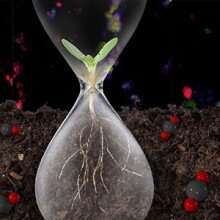Getting to the root of carbon storage in deep soils

Land use changes, nutrient depletion, and drought can make plant roots grow deeper into the soil. But scientists question how that growth affects carbon in the soil. Could more roots reaching deep soil layers result in more carbon being sequestered? Or will this root-driven mineral weathering unlock older carbon in deep soils? Combining advanced imaging techniques, scientists examined the impact of roots on organic carbon compounds and their association with minerals in soil. The results suggest that the age and mineral composition of the soil as well as the amount of time it has undergone root-driven weathering dictates whether roots promote the storage or release of carbon.
Soils contain more than twice the amount of carbon stored in the atmosphere. Most of this carbon resides in deep soils, where it can be stored for millennia. This study showed that root activity in relatively young soils could result in carbon being stored by forming new associations between minerals and organic carbon compounds. In contrast, continued root activity in older soils may disrupt existing associations and cause carbon to be released as climate-active carbon dioxide. The results of this study could help scientists determine which soils can better store carbon at depth and which may be vulnerable to carbon loss.
Scientists from the University of Massachusetts, University of Arizona, and U.S. Geological Survey teamed with two DOE user facilities, the Stanford Synchrotron Radiation Lightsource and EMSL, the Environmental Molecular Sciences Laboratory, to examine deep soils three to more than five feet underground. These soils ranged in age from 65,000 to 226,000 years, and all had portions that had been impacted by the repeated growth of roots. Scientists used a suite of solid-phase analyses, some made possible by EMSL's high-resolution Fourier-transform ion cyclotron mass spectrometry and Mössbauer spectroscopy capabilities, the Stanford Synchrotron Radiation Lightsource, and the scanning transmission X-ray microscopy at the Canadian Light Source.
Combining these techniques gave the team unique insights into the nature of associations between minerals and organic carbon compounds in the soil, including their specificity, particle size, and molecular composition. The patterns of root-driven weathering are in excellent agreement with the conditions found at locations with different soil types, climate, and vegetation. The fundamental processes discovered in this study may therefore be useful for modeling plant root influences on carbon storage in soils globally.
More information: Mariela Garcia Arredondo et al. Root-driven weathering impacts on mineral-organic associations in deep soils over pedogenic time scales, Geochimica et Cosmochimica Acta (2019). DOI: 10.1016/j.gca.2019.07.030
Journal information: Geochimica et Cosmochimica Acta
Provided by Environmental Molecular Sciences Laboratory





















